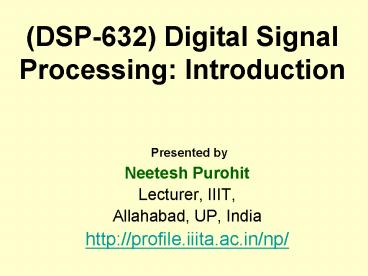DSP632 Digital Signal Processing: Introduction PowerPoint PPT Presentation
1 / 12
Title: DSP632 Digital Signal Processing: Introduction
1
(DSP-632) Digital Signal Processing Introduction
- Presented by
- Neetesh Purohit
- Lecturer, IIIT,
- Allahabad, UP, India
- http//profile.iiita.ac.in/np/
2
Distribution of Internal Marks
- Proportionate marks for attendance (10)
- Quiz marks (1010)
- Unsolved problems at the end of all chapters is
an assignment. You should try to solve 5 problems
within 2 days after completion of a particular
chapter in your assignment copy. (15) - The problem numbers will be (your roll number
x) mod N x0,4,8,12,16 And N number of problems
3
Signal
- A physical quantity that varies with time, space
or any other independent variable(s). - In all practical scenarios it should be an
Information-bearing function. (what is
information?) - E.g. sound air pressure variation at a point as
a function of time p(t) - Dimensionality (no. of variables in the
function) - Sound 1-Dimension
- Greyscale image i(x,y) 2-D
- Video 3 x 3-D r(x,y,t) g(x,y,t) b(x,y,t)
4
The role of signal in Comm. Systems
For a layman, information may be an idea in
someones mind or it may be a news that something
has been happened or will happen etc.
- Information Information
I/P Transducer
O/P Transducer
Electrical signal
Receiver
Transmitter
channel
Twisted Copper wire coaxial cable optical
fiber space
5
Signal processing
- Modify a signal to extract/ enhance/ rearrange
the information. - Origin in analog electronics e.g. In RADAR, the
purpose of processing includes - - Noise reduction
- Data compression
- Representation for recognition/ classification
6
Digital Signal Processing
- DSP Signal processing on a computer
- Two effects discrete-time, discrete level
- The Problem?
7
Digital vs. Analog
- Advantages of Digital Signal Processor
- More flexible.
- Often easier system upgrade.
- Data easily stored.
- Better control over accuracy requirements.
- Reproducibility Cheaper
8
- Limitations
- A/D signal processors speed
- Wide-band signals still difficult to treat
(real-time systems). - Finite word-length effect ( Round-off error
caused by rounding math calculation result to
nearest quantisation level.)
9
Application areas
- Space (Photograph enhancement, Intelligent
sensory analysis etc) - Medical (CT, MRI, ultrasound etc.)
- Commercial (Image and sound compression etc.)
- Telephone (Echo reduction, data compression,
Filtering etc.) - Military (Radar, Sonar, secure communication
etc.) - Industrial (Process Monitoring and control etc.)
10
The syllabus
- Unit I
- Review of signal and system theory
Classification of discrete time signals and
systems, The concept of frequency in CT and DT
signals, Analysis of discrete time linear time
invariant systems, Correlation of discrete time
signals, Z-domain analysis. - Unit II
- Fourier series and Fourier transform analysis of
discrete signals and DTLTI systems, Inverse
systems and deconvolution, Discrete Fourier
transform, circular convolution and other
properties of DFT, Linear Filtering based on DFT,
frequency analysis of signals using DFT.
11
- Unit III
- Fast Fourier Transform algorithms and their
applications, Quantization effects in the
computation of the DFT, Short Time Fourier
Transform, Wavelet Transform. - Unit IV
- Structures for IIR and FIR systems,
representation of numbers, quantization of filter
coefficients, round off effects, Design of
digital filters, linear prediction and optimum
linear filters.
12
Books
- Text Book
- DSP Principles, algo and app, III edition
authored by PROAKIS, PE. - Reference book
- DTSP, II edition, authored by Oppenheim and
Schafer, PHI.

